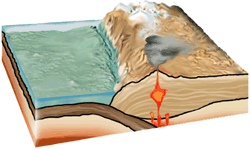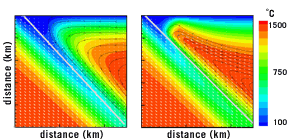
|
 |
Science Highlights > Rethinking Subduction Zones
Rethinking Subduction Zones
 |

Click to enlarge
|
|
When an ocean plate collides with another oceanic plate or with a plate carrying continents, one plate will bend and slide under the other. As the subducting plate plunges deep into the mantle, the top gets hot enough to melt. Molten rock and hot fluids rise through the rock, creating additional melt. The melt forms new crust and volcanos at the surface of the overiding plate. |
Earth’s surface comprises separate, moving plates, some carrying continents and others made primarily of oceanic crust. When an oceanic plate collides with another plate, it slides beneath it in a process called subduction. Beyond this simple picture, what happens beneath the surface has been debated for 40 years.
As the subducting plate plunges into the mantle, magma is generated that can erupt at the surface of the overriding plate. The process can create volcanic “arcs”: volcanic mountain chains on land, such as the Cascades, or volcanic island chains, such as the Aleutian Islands. But the thermal models that attempt to explain heat distribution, volcanism and other processes in subduction zones did not seem to fit the observed phenomena.
Recent evidence shows that the composition of rocks from arcs indicates that temperatures in the mantle wedge (the area beneath the arc and above the subducting plate) are much hotter at shallower depths than predicted by thermal models—for example, from 20 to 30 miles deep (30 to 45 kilometers), existing models predicted 1,100° to 1,500°F (600° to 800°C), whereas lava composition requires temperatures of 2,400°F (1,300°C) or higher at those depths
Were the geophysicists’ models missing important aspects of subduction processes? Or were petrologists and volcanologists misinterpreting chemical data?

Click to enlarge
|
 |
|
Traditional thermal models, left, of subduction zones assumed a rigid plate atop a constant viscosity mantle wedge, leading to cooler temperatures at shallower levels than a model produced by WHOI Senior Scientist Peter Kelemen and colleagues. Their model does not impose a rigid plate and allows wedge viscosity to vary with temperature.
|
Peter Kelemen, Senior Scientist in the Geology and Geophysics Department, working with colleagues from Brown University and the University of California Santa Barbara, recently integrated petrological and geochemical data on wedge temperatures with knowledge of subduction zone dynamics to solve this problem. Traditional thermal models of subduction zones assumed a rigid top above a constant viscosity mantle wedge. In a paper in press, Kelemen and colleagues show that if this upper plate is not so rigid and the wedge’s viscosity varies with temperature, the thermal models and volcanic data can easily be reconciled.
This simple modification of subduction zone models has resolved a decades-old paradox and significantly improved our understanding of arc volcanism.
Kelemen’s work is funded by the National Science Foundation.
|
|
